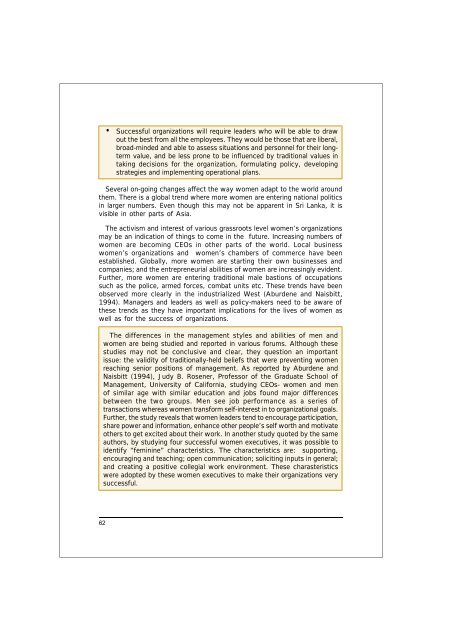Beyond Glass Ceilings and Brick Walls - International Labour ...
Beyond Glass Ceilings and Brick Walls - International Labour ...
Beyond Glass Ceilings and Brick Walls - International Labour ...
You also want an ePaper? Increase the reach of your titles
YUMPU automatically turns print PDFs into web optimized ePapers that Google loves.
• Successful organizations will require leaders who will be able to draw<br />
out the best from all the employees. They would be those that are liberal,<br />
broad-minded <strong>and</strong> able to assess situations <strong>and</strong> personnel for their longterm<br />
value, <strong>and</strong> be less prone to be influenced by traditional values in<br />
taking decisions for the organization, formulating policy, developing<br />
strategies <strong>and</strong> implementing operational plans.<br />
Several on-going changes affect the way women adapt to the world around<br />
them. There is a global trend where more women are entering national politics<br />
in larger numbers. Even though this may not be apparent in Sri Lanka, it is<br />
visible in other parts of Asia.<br />
The activism <strong>and</strong> interest of various grassroots level women’s organizations<br />
may be an indication of things to come in the future. Increasing numbers of<br />
women are becoming CEOs in other parts of the world. Local business<br />
women’s organizations <strong>and</strong> women’s chambers of commerce have been<br />
established. Globally, more women are starting their own businesses <strong>and</strong><br />
companies; <strong>and</strong> the entrepreneurial abilities of women are increasingly evident.<br />
Further, more women are entering traditional male bastions of occupations<br />
such as the police, armed forces, combat units etc. These trends have been<br />
observed more clearly in the industrialized West (Aburdene <strong>and</strong> Naisbitt,<br />
1994). Managers <strong>and</strong> leaders as well as policy-makers need to be aware of<br />
these trends as they have important implications for the lives of women as<br />
well as for the success of organizations.<br />
The differences in the management styles <strong>and</strong> abilities of men <strong>and</strong><br />
women are being studied <strong>and</strong> reported in various forums. Although these<br />
studies may not be conclusive <strong>and</strong> clear, they question an important<br />
issue: the validity of traditionally-held beliefs that were preventing women<br />
reaching senior positions of management. As reported by Aburdene <strong>and</strong><br />
Naisbitt (1994), Judy B. Rosener, Professor of the Graduate School of<br />
Management, University of California, studying CEOs- women <strong>and</strong> men<br />
of similar age with similar education <strong>and</strong> jobs found major differences<br />
between the two groups. Men see job performance as a series of<br />
transactions whereas women transform self-interest in to organizational goals.<br />
Further, the study reveals that women leaders tend to encourage participation,<br />
share power <strong>and</strong> information, enhance other people’s self worth <strong>and</strong> motivate<br />
others to get excited about their work. In another study quoted by the same<br />
authors, by studying four successful women executives, it was possible to<br />
identify “feminine” characteristics. The characteristics are: supporting,<br />
encouraging <strong>and</strong> teaching; open communication; soliciting inputs in general;<br />
<strong>and</strong> creating a positive collegial work environment. These charasteristics<br />
were adopted by these women executives to make their organizations very<br />
successful.<br />
62
















